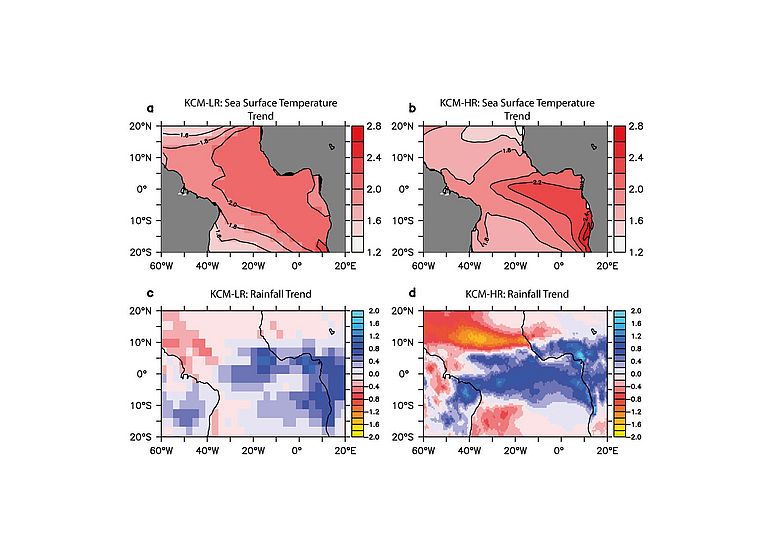Improved models show stronger climate change signal in the tropical Atlantic
Comparative study of the GEOMAR illustrates dependence on model resolution
A long-standing problem in global climate models (coupled ocean-atmosphere-sea ice models) is the too warm sea surface temperatures in the eastern tropical Atlantic, which also influences the nature of the interactions between the ocean and the atmosphere. Simulations at GEOMAR Helmholtz Centre for Ocean Research Kiel show, on the one hand, that temperature errors are much smaller when using in a climate model an atmospheric component with very high resolution. On the other hand, only such a climate model projects a sea-surface temperature response to increasing atmospheric CO2-concentrations that is similar to the warming trends observed since the mid-20th century. Moreover, the atmospheric circulation pattern at the equator, the so-called Walker circulation, is significantly altered in the climate change experiment, leading to greatly increased precipitation in the equatorial region. The scientists have now published the results of their investigations in the international journal npj Climate and Atmospheric Science.
“We have used the Kiel Climate Model in two configurations”, explains lead author Dr. Wonsun Park from GEOMAR. One uses an atmosphere model with a coarse horizontal resolution of just under three degrees (~300 km) and 31 vertical levels, the other a horizontal resolution of about half a degree (~50 km) and 62 levels”, Park continues.
The higher atmospheric resolution greatly reduces the error in the simulated sea surface temperatures of the tropical Atlantic. “This is due to the much better simulation of the surface winds, which is not possible with the coarse-resolution model because the transitions from land to sea regions cannot be represented well enough”, explains co-author Prof. Dr. Mojib Latif from GEOMAR. “The surface winds have a considerable influence on the ocean currents and thus on water temperatures”, explains the climate scientists from Kiel. Thus, according to the authors, the high-resolution atmospheric component configuration of the climate model possibly may provide enhanced future projections in the tropical Atlantic region relative to most other climate models that typically employ a coarse-resolution atmospheric component.
Both model configurations were used in a climate change experiment in which atmospheric carbon dioxide concentrations continue to increase. The response of the two model versions is very different. The high-resolution variant reacts much more sensitive, the atmospheric circulation pattern in the tropics changed fundamentally, the hydrological cycle is increased. In contrast, the coarse-resolution version shows a much weaker atmospheric reaction. “We were somewhat surprised by the clear difference”, says Professor Latif. “But it clarifies that our understanding of all the developments associated with climate change is still immature”, Latif concludes.
Scientific Paper:
Park, W., and M. Latif, 2020: Resolution dependence of CO2-induced Tropical Atlantic sector climate changes. Climate and Atmospheric Science, doi: https://doi.org/10.1038/s41612-020-00139-6



